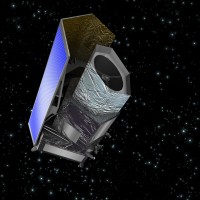Euclid mission jumps final hurdle

The European Space Agency (ESA) has formally adopted the Euclid mission into their Cosmic Vision programme.
To make this adoption a success, the largest astronomical collaboration in history has been formed, and the University of Edinburgh plays leading roles in this endeavour. Adoption marks the final phase in a 6-year selection process and means that the scientists, industry partners and ESA can now start to aim for the expected launch date in 7 years' time.
“This adoption of Euclid by ESA marks the final phase in a long process of developing key ideas to designs a high-powered, super-Hubble Space Telescope capable of probing the fundamental nature of the Universe.” Andy Taylor, Institute for Astronomy, who leads the UK analysis effort for Euclid.
Euclid is a mission whose aim is to reveal the nature of “dark matter” and “dark energy” that make up over 95% of the Universe, but whose nature is a mystery. Determining the nature of dark energy, which won a Nobel Prize for its discoverers, will reveal if there are new forces present in the Universe, or overturn Einstein’s theory of gravity, and will help us to understand the ultimate fate of the Universe.
“Euclid will map the three dimensional structure of the Universe over 75% of its age in unprecedented detail. This will allow cosmologists to trace how the Universe has grown and reveal the nature of dark energy,” said Dr Thomas Kitching (University of Edinburgh), one of the leads of the Euclid Science Working Groups.
“The results from Euclid will necessarily cause a revolution in physics. The phenomenon of dark energy means either that our theory of gravity is wrong, or our theory of particle physics, or both. Only through the exquisite accuracy that Euclid can achieve can we answer these questions.” Thomas Kitching, Institute for Astronomy.
3-D gravitational lensing
Euclid will observe 1.5 billion galaxies from space, building on what cosmologists have learnt from the Hubble Space Telescope. Importantly it is only from space that the blurring effect of the atmosphere, that has prevented cosmologists from understanding dark energy, can be circumvented. One of the primary ways of using this data is by employing an effect called 3D gravitational lensing, a technique pioneered at the University of Edinburgh.
“3-D gravitational lensing produces tiny changes in the images of galaxies which we can use to map out the distribution of dark matter in space and how it evolves over cosmic time. Many of the methods Euclid will employ to do this, and to measure the effects of dark energy, were first developed at Edinburgh,” said Andy Taylor, who also leads the Euclid effort to measure the 3-D gravitational signal.
To measure this effect however is a significant software challenge. To process the data, which would has to be stored on the equivalent of over 10 million CDs, will require an team of software and hardware engineers to work very closely with the scientists.
“The data analysis challenges faced by Euclid are significant, but we believe solvable. Edinburgh will host the UK’s Euclid Science Data Centre and we are already starting to develop new tools which will push computing boundaries to handle the data, well ahead of Euclid’s launch.” Keith Noddle, Institute for Astronomy, who leads the UK Science Data Centre.
The challenge ahead, from now to the launch of Euclid in 2019, will be in developing the tools needed to analyse the data. The rewards however will be worth the effort.

